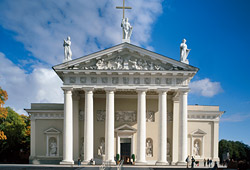The Cathedral Basilica
As reconstructed by Laurynas Stuoka-Gucevičius, the Vilnius Cathedral Basilica is a grandiose, harmonious and monumental building in the classicist style, with 11 lateral chapels, a sacristy, north and south side entrances and a portico at the western end. The symmetrical cupolas of the sacristy and the Chapel of St Casimir rise at the eastern end of the building, while colonnades line both sides. Baroque statues stand in niches among the columns. Looking at the façade, visitors’ eyes are first drawn to six sculptures there: Moses and Abraham in niches at the extremes of the façade, and the four evangelists beyond the columns of the portico. Above the evangelists, five relief sculptures portray the themes of the New Covenant and the Apostolate. Three monumental figures stand atop the Cathedrals front pediment: St Stanislaus, St Helen and St Casimir.
Images of the Apostles painted by the famous Lithuanian artist Pranciškus Smuglevičius (1745–1807) accompany pilgrims down the central nave toward the main altar. The main altar ensemble consists of the architecturally stylized Altar of the Vicars, centred on a painting of the martyrdom of St Stanislaus (P. Smuglevičius, 1799), and the so-called Altar of the Chapter in the elevated presbytery with its historical tabernacle. Scenes on the tabernacle door of Christ’s Passion are an example of high quality baroque goldsmith work. Beside the cross of the tabernacle are silver statues of St Casimir and St Stanislaus, the two main patron saints of the Vilnius diocese. High on a pillar to the right of the old tabernacle hangs a painting of Mary and the Child Jesus, which may date to the 16th century though it was repainted in the late 17th or early 18th century. It is known as Our Lady of Old Trakai. The relatively small image is associated, according to a 19th century tradition, with the name of Vytautas the Great who built the Cathedral.
The eastern wall of the Cathedral sports two paintings by Pranciškus Smuglevičius: “The Multiplication of the Loaves and Fishes” and “The Sacrifice of Melchizedek”. Above the old pulpit in the central nave is an image of the suffering Christ. It is a copy of the painting “Ecce Homo” by the famous Italian artist Guido Reni (1575–1642). The lateral naves contain Stations of the Cross created in 1909 by Nikodemas Silvanavičius (1834–1919). Italian painter Costantino Villani in the second half of the 18th century produced the 16 large paintings of Biblical scenes that hang high up in the lateral naves. A tapestry by Pranciškus Smuglevičius entitled “Peter in Prison Baptizes a Soldier” hangs at the end of the Cathedral, by the main entrance. Opposite is the “Last Supper” painted by Kanutas Ruseckas (1800–1860).
Located at the start of the right nave is the Chapel of Exiles. It is dedicated to Archbishop Mečislovas Reinys (1884–1953) and all the bishops, priests and people of Lithuania who have been unjustly tortured, imprisoned, exiled or forced to emigrate. The chapel also contains the tomb of Vilnius Archbishop Julijonas Steponavičius (1911–1991). Candles constantly burn at the chapel’s altar before an impressive Crucifix from the first half of the 18th century, probably the work of a Spanish Master. The sculpture of Christ Crucified was relocated to Vilnius Cathedral in 1864 from the Church of the Trinitarians in Antakalnis, which had closed.
The Blessed Sacrament is reserved in the Chapel of the Most Blessed Sacrament located beside the Chapel of St Casimir. Above the tabernacle hangs an image of “Christ our Good Hope” (1873), with an iconography that announces the Lord’s mercy. Its gilded silver cover is a votive offering made by devoted persons in thanksgiving for graces received.
In the left nave, moving toward the altar is the “Royal Chapel”, also known as the Valavičius Family Chapel. It was built in 1473 by the Lithuanian Grand Duke and Polish King Casimir Jagiellon and dedicated to the Blessed Virgin Mary, St Andrew and St Stanislaus. At first, the tomb of St Casimir was in the crypt of this chapel. But when he was officially declared a saint, the Polish and Lithuanian ruler Sigismund Vasa built the new Chapel of St Casimir in the southeast corner of the cathedral, where the family of Vilnius Bishop Eustachijus Valavičius (1572-1630) had a chapel. What until then had been the Royal Chapel now passed into the hands of the Valavičius family. The chapel’s altar contains a 17th century painting of the Immaculate Conception of the Blessed Virgin Mary, by an unknown artist. The fact that the image was formerly adorned with a silver covering means it, too, was considered miraculous.
The vaults beneath Vilnius Cathedral, like those of most other European cathedrals, were used to bury prominent political leaders and ecclesiastics. The Vasa kings began to build a royal mausoleum under the Chapel of St Casimir, but the installation seems never to have been completed. It was only during renovation work in the 1930s that the remains of Sigismund Augustus’s wife Elizabeth of Habsburg (1526–1545), Barbora Radvilaitė (1520–1551) and St Casimir’s brother Alexander (1460–1506) were discovered. They are buried, together with the heart of the Polish and Lithuanian ruler Vladislaus Vasa (1595–1648), in a new mausoleum of polished granite just below the chapel. The walls of the Chapel of St Casimir bear Latin inscriptions commemorating the rulers and their spouses who are buried in the mausoleum.
The crypt of Vilnius Cathedral also contains the oldest known fresco in Lithuania, an image of the Crucifixion from the late 14th or early 15th century. It portrays Christ on the Cross, with the Virgin Mary on his right and St John on his left. The fresco, quite deteriorated due to time and moisture, was discovered in 1985. The image most likely adorned the burial place of a member of the ruling family or a bishop.








